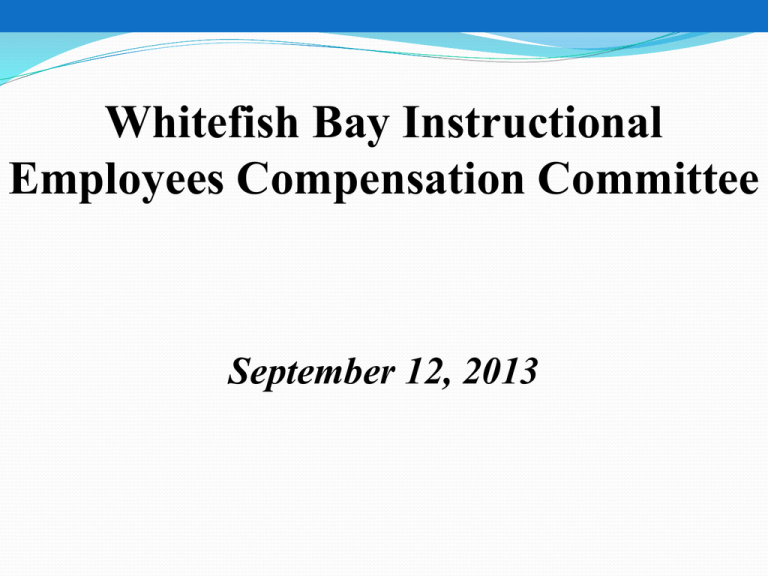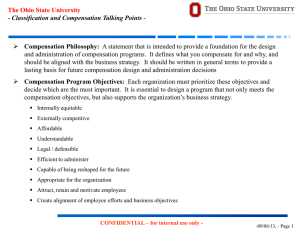
Whitefish Bay Instructional
Employees Compensation Committee
September 12, 2013
Why a Committee?
Wisconsin Act 10 and its impact on teacher
compensation
Evolution of teacher compensation systems
Uniform (traditional) salary schedule.
Ad hoc schedule modifications following Act 10
Laws and other limitations on the design of teacher
compensation systems.
Design components of teacher compensation system
2011 Wisconsin Act 10
Collective Bargaining Changes (effective June 29, 2011)
Prohibits bargaining collectively with respect to any condition of
employment except wages, which includes only total base wages and
excludes any other compensation, such as overtime, premium pay,
merit pay, performance pay, supplemental compensation, pay
schedules, and automatic pay progressions.
Limited to bargaining over a percentage of a total base wage increase no
greater than the percentage change in the consumer price index.
2011 Wisconsin Act 10
School boards are prohibited from bargaining
over
The salary schedule
Pay for additional years of service (step
movement)
Pay for professional development (lane
movement)
School boards are not prohibited from having a
salary schedule or paying step or lane movement
– these are now unilateral decisions made
outside of bargaining. (issue of affordability)
Act 10 gives school boards the power to design
new teacher compensation systems outside of
bargaining.
Evolution of Teacher
Compensation Systems
Uniform salary schedule.
Ad hoc schedule modifications following Act 10.
Alternative compensation systems.
The Uniform Salary Schedule
Step
1
2
3
4
5
6
7
8
9
10
11
12
13
14
15
16
BA
39,573
40,103
40,765
41,847
42,932
44,017
BA+6
40,335
40,865
41,527
42,610
43,694
44,778
45,860
46,945
48,028
49,219
BA+12
41,032
41,625
42,290
43,372
44,456
45,539
46,624
47,707
48,789
49,981
51,175
52,367
53,592
54,851
56,142
BA+18
41,858
42,389
43,051
44,134
45,220
46,302
47,385
48,468
49,552
50,744
51,935
53,127
54,352
55,613
56,903
BA+24
42,620
43,150
43,812
44,894
45,979
47,063
48,147
49,232
50,314
51,506
52,698
53,890
55,115
56,374
57,697
59,089
BA+30
43,382
44,042
44,774
45,855
46,940
48,023
49,107
50,191
51,274
52,465
53,658
54,983
56,342
57,732
59,188
60,777
MA
44,144
44,936
45,799
46,991
48,183
49,375
50,568
51,760
52,952
54,210
55,468
56,860
58,284
59,774
61,397
63,151
MA+6
44,936
45,799
46,726
47,917
49,110
50,305
51,496
52,689
53,879
55,138
56,528
58,052
59,608
61,232
62,987
64,907
MA+12
45,734
46,594
47,521
48,714
49,906
51,098
52,291
53,482
54,674
55,933
57,323
58,846
60,470
62,158
63,981
66,032
MA+18
46,661
47,521
48,449
49,641
50,833
52,024
53,228
54,409
55,600
56,860
58,251
59,774
61,431
63,152
65,008
67,093
MA+24
47,588
48,779
49,973
51,230
52,488
53,746
55,005
56,264
57,523
58,846
60,304
61,891
63,615
65,404
67,327
69,577
• Vertical steps represent pay for added year of service.
• Horizontal steps represent pay for additional education.
• Vertical and horizontal step movement is automatic – the school district has
committed itself to pay the salary increases inherent in step movement.
MA+30
48,514
50,040
51,494
52,818
54,146
55,466
56,799
58,119
59,438
60,838
62,357
64,016
65,804
67,653
69,646
72,050
The Uniform Salary Schedule
Problems:
Pay increases are automatic.
Sustainability- State Resources/Ability to pay
Boards and administrations lack control over teacher continuing
education yet must pay increased salaries for it.
School board cannot control cost increases resulting from step movement.
The public may question whether the school board has given up too
much.
Advantages:
Pay increases are automatic. There is a mechanism to move new
teachers through the schedule to eventual pay equity with senior
teachers.
Uniform schedule was highly predicable for teachers.
Schedule Modifications
Before Act 10, most unions resisted modifications of the
uniform salary schedule.
Act 10 gave school boards the power to change the
schedule and determine salary increases without union
consent.
Many school boards made salary decisions to meet
immediate needs without thought of long term
implications.
The immediate need was the reduction in state aid and revenue
limit authority in 2011-12.
Ad Hoc Schedule Modifications Collective Bargaining
2011-12:
Approximately 2/3rd of Wisconsin schools settled contracts
before Act 10 took effect.
Most of those settled while Act 10 was pending.
Typical settlement involved no salary increase and no step and
lane movement, employee payment of the employee share of
WRS and a greater employee contribution toward insurance.
Ad Hoc Schedule Modifications Collective Bargaining
2011-12:
The other 1/3rd of Wisconsin schools:
Many also froze teachers in step and lane.
All required employees to pay employee share of WRS and most
required greater employee insurance contributions.
Across-the-board pay increases were more common with the
schools that did not settle before Act 10 became law.
Some schools eliminated salary schedules, replacing those with
lists of names and salaries.
A very small number of schools started working on alternative
compensation systems.
Ad Hoc Schedule Modifications Collective Bargaining
2012-13:
About 1/3rd of schools have pre-Act 10 contracts.
Many schools freeze step and lane movement again,
although some are realizing that doing so creates a long term
problem.
Teacher unions prioritize across-the-board pay increases.
Ad Hoc Schedule Modifications Unilateral Actions
Schools with no pre-Act 10 contract start making
unilateral modifications to schedules:
If the starting pay is too low, board may delete step from
schedule, effectively giving step movement to some teachers
but not others.
Schools that have froze teachers in step for one or more
years grant lane movement to some teachers but not others.
Ad Hoc Schedule Modifications
Long term implications of the ad hoc/transitional schedule
modifications:
An arbitrary salary schedule where it becomes increasingly
difficult to explain why teachers are paid what they are paid.
Teachers in similar positions with similar education and years of
service may be paid different amounts.
Teacher morale may suffer, staff turnover may occur
Discrimination suits over compensation may become a possibility.
Laws and other limitations on the
design of teacher compensation
systems
Considerations – Legal Implications
Individual Contract: Relationship to Wis.
Stats. 118.21 and 118.22, i.e. teacher contract
statute and teacher renewal of contracts statute.
◦ Wis. Stats. 118.21 requires that the teacher’s
salary be listed on the individual contract.
◦ Can salary be reduced without going through
the nonrenewal process under Wis. Stats.
118.22?
Considerations – Legal
Implications
Public Records:
Teacher compensation is a public
record that is subject to release.
Teacher evaluations are not a public
record subject to release.
A pay system that pays teachers more
for positive evaluations is subject to
release.
Considerations – Legal Implications
Employment Discrimination Law: How will the
compensation system be structured in order to
minimize exposure to the following:
Age discrimination in employment claims;
Gender/sex discrimination in employment
claims; and
Other prohibited bases of discrimination
under state and federal law.
Considerations – Legal Implications
Title VII of the Civil Rights Act of 1964
Wisconsin Fair Employment Act
Equal Pay Act
Section 1981
Section 1983
Americans with Disabilities Act
Age Discrimination in Employment Act
Retaliation
Considerations – Legal Implications
Equal Pay Act
◦ The Equal Pay Act prohibits employers from
discriminating against both male and female
employees on the basis of sex by paying
different rates ". . . for equal work on jobs the
performance of which requires equal skill,
effort, and responsibility, and which are
performed under similar working conditions . .
. ." (29 U.S.C. 206(d))
◦ Exceptions exist where the difference is due to
a bona fide seniority system, merit system, a
system which measures compensation by
quantity or quality of production or a
differential based on a factor other than sex.
The law is enforced by the EEOC.
Considerations – Legal Implications
If the Compensation System uses Student Data
◦ Student Progress
Value added models
Individual student tracking [measurements within a
specified period of time]
Implications
118.30 (2) (c) The results of examinations
administered under this section or under 20 USC
6311 (b) (3) to pupils enrolled in public schools,
including charter schools, may not be used as the
sole reason to discharge, suspend, or formally
discipline a teacher or as the sole reason for the
nonrenewal of a teacher's contract.
Designing a Compensation System
Design Components of Teacher
Compensation System
What do we want out of our compensation system?
Attract and retain the best staff.
Some differentiation in starting wage may be necessary to attract
teachers to hard-to-fill certifications.
Some differentiation in starting wage may be needed to attract
other skill sets such as multiple certification teachers or teachers
with special training.
Minimize damage to teacher morale resulting from salary
differentiation.
Design Components of Teacher
Compensation System
What do we want out of our compensation system? (Continued)
Motivate staff to pursue professional development of value to the
school district.
Professional development to meet specific needs of the district.
Professional development that helps individuals improve their
performance to increase student achievement.
Develop and utilize teacher leaders to support peers and the
district initiatives.
Ensuring equity in the system by not rewarding under performance.
Sustainability / Ability to Fund
Consideration of long term financial health of the School District.
Design Components of Teacher
Compensation System
Where do teachers new to the district start?
BA Base?
Pay increases for years of service or experience?
Pay for prior experience in other districts?
Additional pay for continuing education?
Additional pay for difficult to fill certification?
Other differentiations?
Next Steps
Educate and Study:
Analyze Compensation from Districts with whom we compete for
employees.
Study other compensation models.
Develop Compensation System - propose to the School Board
Key Steps in the Process:
Involve instructional employees (from each school) in committee work.
Solicit feedback from instructional employees on criteria for compensation structures.
Provide appropriate progress reports and communications to the School Board and
Stakeholders.
Assess the cost implications of proposed structures on School Districts financial
resources.






